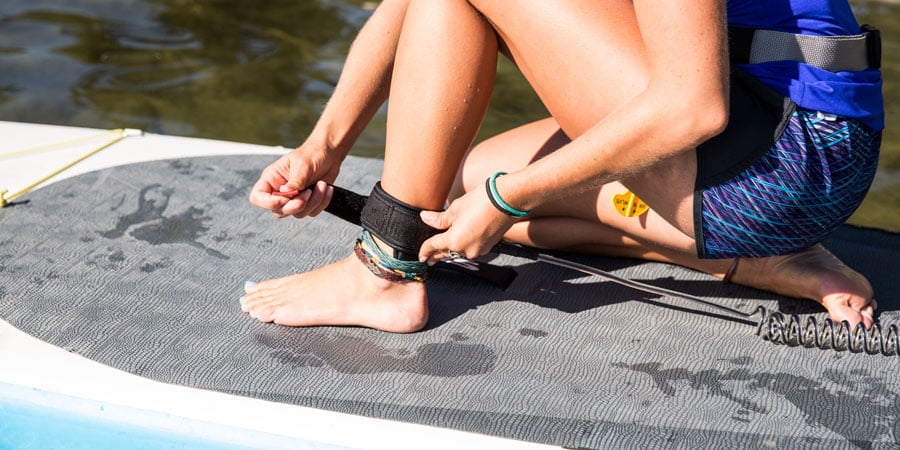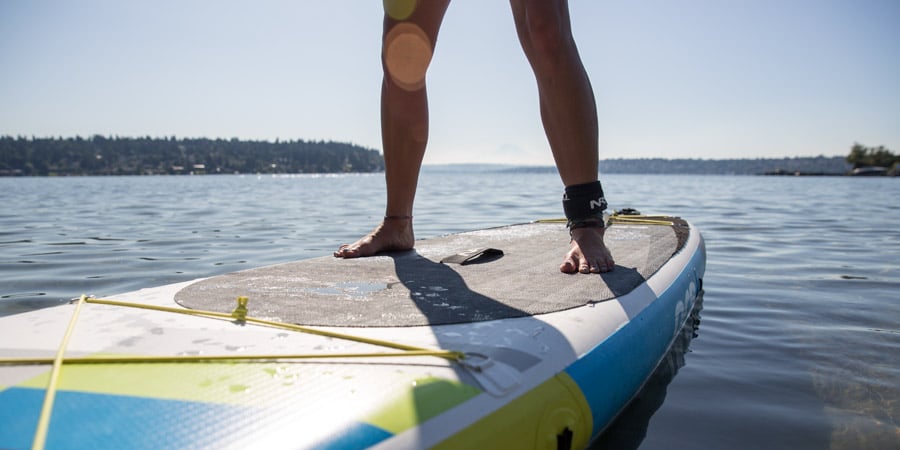If you're wondering why someone would choose to do yoga on a wobbly surface like a stand up paddle board, you're not alone. After all, isn't it hard enough to hold those poses on solid ground?
It's a common question, but as you'll come to find out when you give it a try, doing yoga on a paddle board is not as hard as it looks and it even offers opportunities that a land-based practice doesn't. SUP yoga can be a delightful way to experience nature and invigorate your yoga practice.
In this article, we explore:
- Why people do SUP yoga: There are many reasons; having fun, experiencing nature and practicing mindfulness are a few.
- Gearing up for SUP yoga: You need the essentials, such as a board, paddle, leash and PFD, and you may consider an anchor, as well.
- Tips and poses for SUP yoga: Some poses are easier than others on a paddle board, and knowing a few helpful tips will set you up for greater success on your first outing.
Having some experience in either SUP or yoga is helpful before trying SUP yoga, but by no means do you need to be an expert in either. A great way to try it out for the first time is to take a SUP yoga class.
Video: SUP Yoga Basics
Why Do SUP Yoga?
Stand up paddle boarding and yoga may at first seem like an odd pairing. But, there are many reasons why people enjoy doing yoga on the water. In addition to having fun with friends or experiencing some quiet solitude on the water, here are a few more benefits:
To get a different kind of workout: Doing yoga on a SUP engages muscles that you may neglect during your on-land practice.
To develop mindfulness: The added challenge of doing yoga on a wobbly board will force you to be very present and intentional with all your movements.
To encourage a beginner's mindset: If you've been practicing yoga for some time now, you might be on autopilot as you do downward facing dog for the thousandth time. But, even the most experienced yogis can learn something new from simple poses, and approaching your yoga practice with the engaged and curious mind of a beginner is a good way to do so. SUP yoga is a great way to work on maintaining a beginner's mindset because it introduces new challenge to your yoga routine.
Gear for SUP Yoga

You'll need the essential gear that you'd take out for a typical day of paddling, which includes:
Stand up paddle board: There are a handful of boards made specifically for SUP yoga, but almost any wide, stable one with a flat shape to the deck will do. It's helpful to have a board with soft, cushy deck padding that extends toward the nose and tail of the board. This will make holding poses more comfortable. Learn more about choosing a SUP.
Paddle: Any SUP paddle will do; just make sure it's properly sized for you. While you're doing yoga, you can simply set the paddle down perpendicular to your board and near the nose. Or, with a coil leash, you can wrap the leash around your paddle a few times, then let it float behind you in the water. With a non-coil leash, tightly secure the hook-and-loop strap to the shaft. The leash will keep the paddle from getting away. Learn more about SUP paddles.
Leash: Typically sold separate from a board, a leash tethers your SUP to you, keeping the board close by if you fall off. For SUP yoga, use the leash while paddling out from shore and then take it off your leg once you've anchored your board in place. If you don't anchor your board, keep the leash on so that your board won't get away if you fall off.
Personal flotation device (PFD): You're required to have a PFD with you while you're out on the water. It's always a good idea to wear a PFD, but the Coast Guard only requires that adults have one on board (different rules apply to children so check your state's laws about PFD use). If you do wear one, consider a low-profile and compact inflatable PFD that won't get in the way during your yoga routine. Learn more in our PFDs: How to Choose article.
Emergency whistle: This is another Coast Guard requirement. Many paddlers keep their whistle attached to their PFD in case they need to signal for help.
Optional gear:
Anchor: You don't have to anchor your board, but some SUP yogis find it distracting to be drifting around during their routine. Also, if you're doing yoga with a group, being anchored can help keep everyone together.
To anchor your board, you can use a simple fishing anchor designed for anchoring kayaks, SUPs and other small boats. Here's how:
- Attach the end of the anchor rope to the leash attachment point on your board and place the anchor and rope on your board.
- Paddle out to a spot that's about 10 or 15 feet deep and lower the anchor overboard.
- When the anchor reaches the bottom, let out a few more feet of rope. If you have excess rope, tie off the strand that's going down to the anchor to the leash attachment point. Pile up excess rope on the tail of your board.
For list of other items that you may want to take along, see our Stand Up Paddle Boarding (SUP) Checklist.
Tips for SUP Yoga

If you've never done SUP yoga before, or even if you have, these tips will help you feel more comfortable on your board.
Find a sheltered spot: Lots of wind and big waves can make SUP yoga really difficult and they can distract you from your yoga practice. Paddle to a place that's relatively sheltered from wind and doesn't see a lot of high-speed boat traffic that will kick up a big wake.
Get away from the crowds: There's something about doing yoga on a SUP that makes people stop and take notice. If you don't like being the center of attention, put some distance between you and the busy beach.
Move slowly: If you've done yoga on land but never on a SUP, start by moving through your poses a tad more slowly than you're used to.
Keep a wide stance: Some styles of yoga focus on a narrow body alignment, such as keeping your feet together in mountain pose or having your front foot in line with your back foot in warrior poses. With SUP yoga, it's helpful to use a wider stance, roughly hip-width-distance apart, for a more stable base.
Keep two points of contact with the board: Poses with only one point of contact, like tree pose or eagle pose, are generally considered too difficult for SUP yoga. Try poses that maintain at least two points of contact. Also, poses that keep your body aligned perpendicular to the board will feel more stable than those that put you parallel to the board (such as warrior I or II).
Embrace the unexpected: SUP yoga is less controlled than an on-land practice. Your board can drift this way and that, a sudden wave may set you off balance, and you may fall in. Try to be OK with that and recognize that, just as in life, you cannot have complete control over everything that will happen.
Sample SUP Yoga Routine
For suggestions of SUP yoga poses to try the next time you go paddle boarding, check out our SUP yoga routine. You can print it out, laminate it and secure it to your board with the deck rigging so you can reference it during your practice.
Printable SUP Yoga Routine (PDF)


